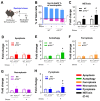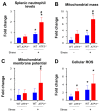Restraint Stress-Induced Neutrophil Inflammation Contributes to Concurrent Gastrointestinal Injury in Mice
- PMID: 38791301
- PMCID: PMC11121713
- DOI: 10.3390/ijms25105261
Restraint Stress-Induced Neutrophil Inflammation Contributes to Concurrent Gastrointestinal Injury in Mice
Abstract
Psychological stress increases risk of gastrointestinal tract diseases. However, the mechanism behind stress-induced gastrointestinal injury is not well understood. The objective of our study is to elucidate the putative mechanism of stress-induced gastrointestinal injury and develop an intervention strategy. To achieve this, we employed the restraint stress mouse model, a well-established method to study the pathophysiological changes associated with psychological stress in mice. By orally administering gut-nonabsorbable Evans blue dye and monitoring its plasma levels, we were able to track the progression of gastrointestinal injury in live mice. Additionally, flow cytometry was utilized to assess the viability, death, and inflammatory status of splenic leukocytes, providing insights into the stress-induced impact on the innate immune system associated with stress-induced gastrointestinal injury. Our findings reveal that neutrophils represent the primary innate immune leukocyte lineage responsible for stress-induced inflammation. Splenic neutrophils exhibited elevated expression levels of the pro-inflammatory cytokine IL-1, cellular reactive oxygen species, mitochondrial burden, and cell death following stress challenge compared to other innate immune cells such as macrophages, monocytes, and dendritic cells. Regulated cell death analysis indicated that NETosis is the predominant stress-induced cell death response among other analyzed regulated cell death pathways. NETosis culminates in the formation and release of neutrophil extracellular traps, which play a crucial role in modulating inflammation by binding to pathogens. Treatment with the NETosis inhibitor GSK484 rescued stress-induced neutrophil extracellular trap release and gastrointestinal injury, highlighting the involvement of neutrophil extracellular traps in stress-induced gastrointestinal inflammation. Our results suggest that neutrophil NETosis could serve as a promising drug target for managing psychological stress-induced gastrointestinal injuries.
Keywords: NETosis; activating transcription factor 3; gastrointestinal injury; neutrophil extracellular trap; restraint stress.
Conflict of interest statement
The authors declare no conflicts of interest.
Figures






Similar articles
-
Gut Microbiota Restricts NETosis in Acute Mesenteric Ischemia-Reperfusion Injury.Arterioscler Thromb Vasc Biol. 2020 Sep;40(9):2279-2292. doi: 10.1161/ATVBAHA.120.314491. Epub 2020 Jul 2. Arterioscler Thromb Vasc Biol. 2020. PMID: 32611241 Free PMC article.
-
Mechanism of pulmonary immunosuppression: extrapulmonary burn injury suppresses bacterial endotoxin-induced pulmonary neutrophil recruitment and neutrophil extracellular trap (NET) formation.FASEB J. 2019 Dec;33(12):13602-13616. doi: 10.1096/fj.201901098R. Epub 2019 Oct 2. FASEB J. 2019. PMID: 31577450 Free PMC article.
-
Induction of neutrophil extracellular traps during tissue injury: Involvement of STING and Toll-like receptor 9 pathways.Cell Prolif. 2019 May;52(3):e12579. doi: 10.1111/cpr.12579. Epub 2019 Mar 9. Cell Prolif. 2019. PMID: 30851061 Free PMC article.
-
The Role of Neutrophil NETosis in Organ Injury: Novel Inflammatory Cell Death Mechanisms.Inflammation. 2020 Dec;43(6):2021-2032. doi: 10.1007/s10753-020-01294-x. Inflammation. 2020. PMID: 32830308 Free PMC article. Review.
-
NETosis in ischemic/reperfusion injuries: An organ-based review.Life Sci. 2022 Feb 1;290:120158. doi: 10.1016/j.lfs.2021.120158. Epub 2021 Nov 23. Life Sci. 2022. PMID: 34822798 Review.
Cited by
-
Targeted Delivery to Dying Cells Through P-Selectin-PSGL-1 Axis: A Promising Strategy for Enhanced Drug Efficacy in Liver Injury Models.Cells. 2024 Oct 27;13(21):1778. doi: 10.3390/cells13211778. Cells. 2024. PMID: 39513885 Free PMC article.
References
-
- Sapolsky R.M. Why Zebras Don’t Get Ulcers. 3rd ed. W. H. Freeman; New York, NY, USA: 2004.
MeSH terms
Substances
Grants and funding
LinkOut - more resources
Full Text Sources
Medical

